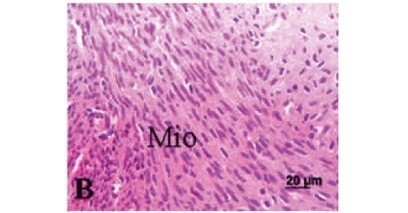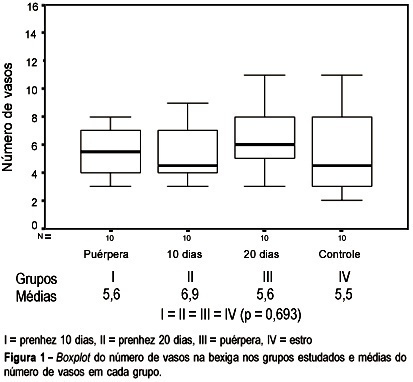Summary
Revista Brasileira de Ginecologia e Obstetrícia. 2006;28(4):227-231
DOI 10.1590/S0100-72032006000400004
PURPOSE: to evaluate histomorphometric changes in the rat myometrium upon treatment with isoflavones, as compared with estrogens, using histological and morphometric techniques. METHODS: twenty-eight oophorectomized adult rats were randomly divided into four treatment groups: GPropi = propylene glycol (control); GExtr10 - 10 mg/kg soybean extract; GExtr300 - 300 mg/kg soy bean extract; GCee - 200 µg/kg conjugated equine estrogens (Cee). Drugs or drug vehicle were administered by gavage once a day for 21 days. Upon sacrifice, the uteri were removed and weighed. Fragments of uterine horns were collected and fixed in 10% formaldehyde and processed for paraffin inclusion. The histological sections were stained by hematoxylin and eosin and evaluated microscopically by means of an image analyzer to quantify the myometrial thickness and the number of blood vessels and eosinophils. The data were studied by analysis of variance (ANOVA) followed by the Tukey-Kramer multiple comparison test. RESULTS: isoflavones in the concentration of 300 mg/kg induced a significant increase in the myometrium thickness (GExtr300=25.6±5.0 mm) compared to control (GPropi=5.5±0.5 mm). The effect of this high dose is similar to the estrogen effect (GCee=27.5±7.9 mm). In low doses (10 mg/kg), the effect was similar to control. Isoflavones (GExtr300) induced also an increase in the number of blood vessels (GPropi=3.5±1.6; GExtr300=10.2±3.6 vessels/mm²) and of eosinophils (CPropi=0.15±0.01; GExtr300=4.3±0.9 eosinophils/mm²). These effects were comparable to those produced by Cee treatment in GCee (9.2±1.1 eosinophils/mm²). CONCLUSION: a high-dose treatment with isoflavones (300 mg/kg per day, 21 days) elicited an estrogen-like, highly significant proliferative action on the rat myometrium.

Summary
Revista Brasileira de Ginecologia e Obstetrícia. 2004;26(3):227-232
DOI 10.1590/S0100-72032004000300009
PURPOSE: to identify the risk factors associated with the occurrence of surgical site infection (SSI) in surgeries for the treatment of breast cancer. METHODS: the study was conducted on 140 women submitted to treatment of invasive breast cancer during the period from January 2001 to December 2002. SSI was defined as infection occurring up to 30 days after surgery and was related to the operation, according to the standard criteria adopted by the Centers for Disease Control and Prevention (CDC), USA. SSI were considered to be superficial when they involved only the skin and subcutaneous tissue and deep when they involved deep tissues at the site of incision, such as fascia and muscles. The risk factors related to patient were age, hormonal status, staging, body mass index (BMI) and hemoglobin, and the factors related to surgery were type of operation, time of hospitalization, duration of surgery, and formation of seroma and hematoma. Data concerning numerical nonparametric variables were analyzed by the Mann-Whitney test and quantitative variables were analyzed by the Fisher exact test. RESULTS: of the 140 patients studied, 29 (20.7%) presented SSI, which were superficial in 19 (13.6%) and deep in 10 (71%); 111 patients did not present SSI and represented the control group. The risk factors associated with the patient and the disease were locally advanced stage (odds ratio = 27; 95% CI: 1.1-6.5) and obesity, represented by a mean BMI of 32.2 kg/m² in the patients with SSI and a mean BMI of 27.2 kg/m² in the control group (p<0.0001). The factors related to treatment of the disease were the use of neoadjuvant chemotherapy (odds ratio = 2.7 (95% CI: 1.1-6.5), the duration of surgery, whose median value was 165 minutes for the patients who developed the infection and 137 minutes for the control group (p=0.02), and the number of days of use of the postoperative drain, whose median value was 6 days for the patients with SSI and 5 days for the control group (p=0.048). CONCLUSION: on the basis of the identification of risk factors such as advanced stage, neoadjuvant chemotherapy and obesity, preoperative care for these patients should be emphasized. The use of an accurate surgical technique may reduce the impact of other factors such as surgical time and time of use of the drain.
Summary
Revista Brasileira de Ginecologia e Obstetrícia. 2002;24(4):227-231
DOI 10.1590/S0100-72032002000400003
Purpose: to evaluate the variations in vascular anatomy by assessing the number of vessels of the proximal and distal urethra, of the vesicourethral canal and of the bladder, during and after pregnancy in rats. Method: thirty female rats, with a positive test for pregnancy, were divided into three groups of 10 animals each: GI - rats on the 10th day of pregnancy; GII - rats on the 20th day of pregnancy; GIII - rats on the 5th day of puerperium; a control group (GIV) composed of 10 rats in the estrous phase. The vessels were stained by the method of Masson and counted with a 25-dot integration ocular, coupled to a light microscope, with an objective of 40X. The studied regions were proximal and distal urethra, vesicourethral canal and bladder. Results: there was no significant variation in the vessel number in the bladder, in the vesicourethral canal and in the proximal urethra during gestation. In the distal urethra of the group IV there were 13.7 vessels, less than that observed in the pregnant groups (20.5 to 24.4 vessels). Conclusion: the pregnant rats had a larger number of vessels in the distal urethra than those in the estrous phase. There were no differences regarding the other sites.

Summary
Revista Brasileira de Ginecologia e Obstetrícia. 2012;34(5):228-234
DOI 10.1590/S0100-72032012000500007
PURPOSE: To evaluate habits of sun exposure and sun protection of pregnant women in a public hospital, to assess orientation about photo protection during the prenatal care, and to detect the presence of melasma and its impact on their quality of life. METHODS: A descriptive cross sectional study conducted among women of 18 years old and older, after delivery, who participated in a program of prenatal care in the South Region of Brazil. The sample was non-probabilistic by convenience. Data collection occurred from July to August 2011 through direct interview using a structured questionnaire to obtain personal information and photo protection habits during pregnancy, skin assessment and photographic record of lesions through informed consent. The skin was classified per Fitzpatrick's phototypes and the melasma was diagnosed clinically. In the patients with melasma, the MELASQoL-PB version was applied. The analysis was performed using Statistica®, version 8.0, and the significance level of p<0.05. RESULTS: In the sample (109 mothers) predominated white women (60.6% phototype III), young (average age 24.4 years SD=6.1) and housewives (59.6%). The majority (80%) stayed exposed to sunlight for 1-2 hours per day between 10 am and 3 pm, and from those (72%) did not apply any photoprotection due to lack of sunscreen habit. Other physical means of sun protection were used by 15% of these patients. Information during prenatal care about the risks of sun exposure was reported by 34% of the mothers interviewed. There was a trend toward a significant association between prenatal guidance and daily use of sunscreen (p=0.088). About 20% of mothers had melasma. The average score MELASQol-PB (25) showed a negative impact on quality of life of these patients. CONCLUSION: In these women, sun exposure occurred at inappropriate times, without proper guidance and without the use of an effective sunscreen. The mothers with melasma complained about the appearance of their skin, frustration and embarrassment.
Summary
Revista Brasileira de Ginecologia e Obstetrícia. 2005;27(4):228-228
Summary
Revista Brasileira de Ginecologia e Obstetrícia. 2005;27(4):228-228
Summary
Revista Brasileira de Ginecologia e Obstetrícia. 2014;36(5):228-232
DOI 10.1590/S0100-7203201400050008
It was to assess the quality of life (QOL) of HIV-infected pregnant women using the HIV/AIDS - Targeted Quality of Life (HAT-QoL) questionnaire.
A descriptive study of 60 pregnant women attended at the Multidisciplinary Nucleus of Infectious Diseases During Pregnancy (NUPAIG) - UNIFESP/EPM and in the referral network of the Municipal Office of São Paulo, conducted from February 2011 to October 2012. Sociodemographic and clinical variables were collected from 60 HIV-infected pregnant women who answered the HAT-QoL questionnaire, which included 34 questions about quality of life.
The average age was 30 years and the average period of HIV infection was 5.7 years. Only 8.3% of patients had a CD4 cell score of ≤200 cells/mm³ and 45% showed undetectable viral load. The average domain scores ranged from 47.5 to 83.7. The domains with the lowest scores were financial concerns and concerns about secrecy. The domains with the highest scores and lower impact on quality of life were concerns about medication and confidence in the professional.
In this initial study with 60 pregnant women, we concluded that the HAT-QOL can contribute to the assessment of quality of life in the population of HIV-infected pregnant women in Brazil.